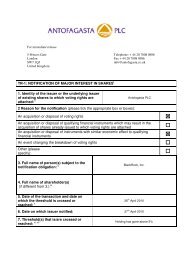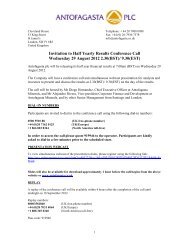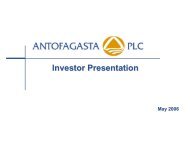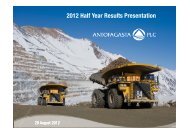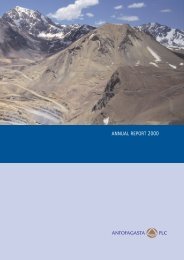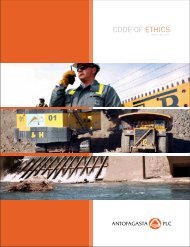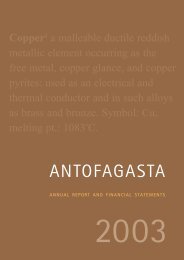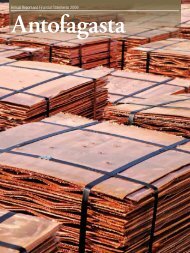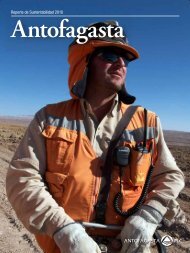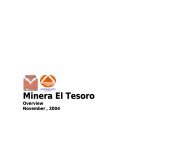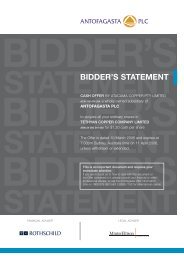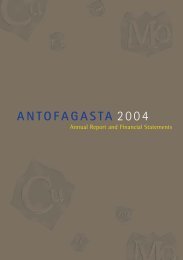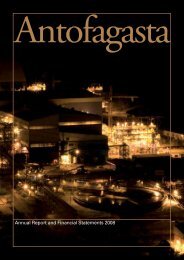Sustainability Report - Antofagasta PLC
Sustainability Report - Antofagasta PLC
Sustainability Report - Antofagasta PLC
Create successful ePaper yourself
Turn your PDF publications into a flip-book with our unique Google optimized e-Paper software.
76<br />
<strong>Antofagasta</strong> plc <strong>Sustainability</strong> <strong>Report</strong> 2011<br />
Aguas de <strong>Antofagasta</strong><br />
Customers and water supply<br />
Aguas de <strong>Antofagasta</strong> focuses on providing safe and clean water to its<br />
customers. The main sustainability issues for our business are:<br />
– Communicating with customers: Timely and open communication with<br />
customers is critical, especially during unplanned interruptions to their<br />
water supply, which can be caused by third-party interventions causing<br />
pipe ruptures and problems with water pressure. The company has a<br />
variety of public communication channels to keep stakeholders fully<br />
abreast of emerging issues. Customers can give their feedback via<br />
dedicated email services, telephone lines and public forums.<br />
– disaster preparedness: Water sources, water production and<br />
distribution infrastructure and wastewater management facilities are<br />
subject to risks of a natural disaster including earthquakes and tsunamis.<br />
Aguas de <strong>Antofagasta</strong>’s emergency committee is responsible for<br />
preventing and managing these risks.<br />
In 2011 the company finished a study simulating the effects a tsunami could<br />
have on its desalination plant, identifying the risks and developing<br />
contingency plans, including plans for co-ordinating with local emergency<br />
authorities.<br />
Northern Chile’s ‘Altiplano Winter’ is a weather phenomenon marked by<br />
heavy summer rainfall that often results in floods that can muddy the water<br />
and increase silt levels. The company’s Emergency Committee evaluates<br />
climate risks and implements contingency plans to reduce the risk of<br />
extreme weather events affecting potable water production.<br />
Our customers are at the heart of what we do and we must ensure they<br />
receive the highest quality water at the right pressure, as well as collecting<br />
and disposing of wastewater safely and efficiently. Customers are most<br />
concerned about being quickly informed of any unexpected interruption to<br />
their water supply. We have improved our communication channels for<br />
informing customers about unexpected emergency work that temporarily<br />
interrupts our services. We contact them via email, automatic telephone<br />
calls and upload information to our website. We have a 24-hour telephone<br />
line for enquiries and we liaise closely with regional, municipal and mayoral<br />
authorities.<br />
The annual customer satisfaction survey by the water authority, SISS,<br />
lowered Aguas <strong>Antofagasta</strong>’s overall satisfaction grade from 6 to 5 (7 being<br />
the highest score) in 2011, compared with 2010. The result associates to an<br />
incident that occurred in March 2011 when a natural algae bloom caused<br />
potable water to have an unpleasant odour.<br />
See environmental management, page 81.<br />
Employees and labour relations<br />
With job opportunities increasing in the region, competition for talented staff<br />
is growing. Being a responsible, inclusive employer helps us to recruit and<br />
retain staff as well as offering competitive remuneration and rewarding our<br />
employees’ loyalty and skills. Our human resource strategy stresses<br />
continued support for individual learning and skills-building for the 267<br />
people we employ.<br />
In 2011 we increased the average training hours from 45 to 56 hours per<br />
employee and 61% participated in the company’s annual training<br />
programme to further develop their technical skills. We also continued our<br />
‘talent programme’ with Universidad del Desarrollo (University for<br />
Development), which was introduced in 2010 to increase leadership skills.<br />
Investment in training<br />
Average hours of training per employee<br />
Total investment in employee training (US$)<br />
2011<br />
56.1<br />
151,230<br />
2010<br />
44.6<br />
119,636<br />
2009<br />
37.7<br />
89,283<br />
Forty-seven employees from all levels and departments participated in our<br />
annual Innovation Contest. The competition encourages interdisciplinary teams<br />
to work together to tackle the company’s strategic challenges, allocating each<br />
team a budget to develop their ideas to improve company practices. It fosters<br />
teamwork and leadership skills and all entries are assessed by Aguas de<br />
<strong>Antofagasta</strong>’s executive team against the criteria of innovation, sustainability<br />
and benefits to the company.<br />
In 2011, we began working with a Chilean government body called Corfo<br />
which promotes entrepreneurship and innovation. We began to implement<br />
Corfo’s Supplier Development Programme, working with suppliers to help<br />
them meet company standards. Running for two years and funded jointly by<br />
Aguas de <strong>Antofagasta</strong> and the Chilean state through Corfo, the programme<br />
is designed to improve our contractors’ performance standards. The first<br />
step of the programme is to analyse gaps in suppliers’ procedures and<br />
practices.



